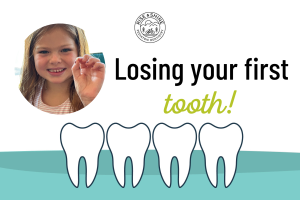Losing your first tooth? A child’s first wiggly tooth can be both exciting and anxiety provoking at the same time. Loose teeth can feel funny or uncomfortable when eating, and can also make it trickier to brush well. It’s important to brush loose teeth with a parent’s help so that food and plaque don’t get stuck underneath them, since this can make the gum tissue irritated and unhealthy just as new permanent teeth are preparing to come in. It’s good to wiggle a loose baby tooth because a baby tooth that stays in your child’s mouth too long can cause permanent teeth not to come into the correct position.
The first teeth to become loose are usually the lower front teeth, followed by the upper front teeth 6-12 months later. The American Academy of Pediatric Dentistry provides a table of average times for tooth eruption, but every child’s schedule may be a little different. Dr. Villasenor will pay close attention to the order that teeth fall out and permanent teeth come in, which is more important than exactly how old your child is. The average age for losing the first tooth is 6 years old, though anywhere from 5-8 years old is normal.
When your child wiggles out a loose baby tooth, the gums might be irritated, so it is important to brush the surrounding teeth well and use warm salt water rinses to help irritated gums heal. If your child is unable to wiggle out a loose baby tooth on their own, call Dr. Villasenor at 303-758-0223 to schedule an appointment so that she can help make sure your child’s smile stays healthy and strong.

